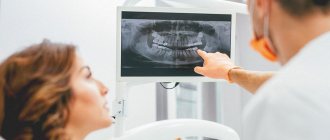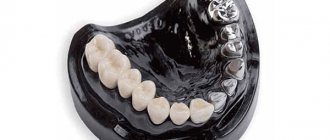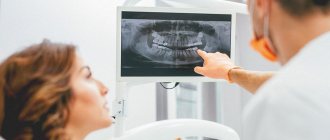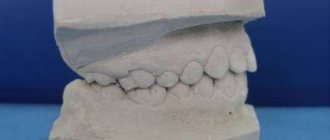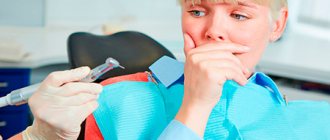What is needed to make a diagnosis for an orthopedic patient?
At the first visit to an orthopedic doctor, the patient is examined. Dentistry and orthopedics provides basic and additional examination methods.
The main examination methods include:
- Collection of complaints: at this point, the doctor asks the patient what the patient is complaining about right now. Accordingly, the doctor clarifies the problems that, from the patient’s point of view, need to be solved: difficulties in chewing food, mobile teeth, sensitivity in certain areas, pain when chewing in the temporomandibular joint, bleeding, pain in teeth covered with orthopedic structures and rubbing or poor fixation denture.
- Collecting an anamnesis of the disease: here the doctor clarifies the time frame - how long ago and how intensely certain complaints are bothering you.
- Collection of general anamnesis:
Past diseases: the general condition of the body, all diseases that the patient suffers from and data on allergic reactions are specified.
Visual inspection. The doctor examines the patient externally - the skin, the condition of the lymph nodes, whether the mouth opens freely and any external defects.
- The condition of the TMJ is determined without additional examination methods, that is, they pay attention to the degree of opening, uniformity of movement, the presence of clicks, crunching and pain when moving the joint, and also note the condition of the masticatory muscles.
- Next, the oral cavity is examined directly and a dental formula is drawn up. A dental formula is a short table in which, opposite each tooth, the doctor makes a note about caries or other disease, whether this tooth is covered with a crown, whether it is damaged or missing, and the degree of mobility is also noted. Under the table, a note is made about the presence, nature and location of dental plaque.
- Condition of the oral mucosa – the color of the mucosa and its condition are noted: degree of moisture, identified pathologies.
- Next, the doctor focuses directly on examining the teeth that the patient is complaining about - their condition, position in the dentition, abrasion, mobility, whether the roots of the teeth are exposed and whether there is sensitivity during probing or from temperature stimuli, as well as the presence and size of periodontal gum pockets.
They also separately describe the condition of fillings or carious defects, orthopedic structures - both removable and non-removable: the condition of inlays, crowns, removable dentures - the integrity of the prosthesis, fixation of the prosthesis, how well the prosthesis corresponds to the boundaries.
- The doctor also pays attention to the bite - the way the patient closes his teeth. This can provide a lot of data to determine the cause of the pathology.
Dentures
Dentures are structures designed for full or partial restoration of the dentition. There are three types of prostheses:
- Removable;
- Fixed;
- Partially removable.
For each individual case, the orthopedic dentist selects an individual type of design. Its choice depends on many factors: the health of the patient’s body as a whole, structural features of the maxillofacial area, the presence of other oral diseases, treatment methods used in this clinic.
Innovative materials and the latest technologies in the field of orthopedic treatment allow us to achieve excellent results. The service life of modern prostheses reaches more than 10 years. They are distinguished by excellent aesthetic qualities, comfort and ease of wearing.
Artificial teeth used on modern structures are almost impossible to distinguish from natural teeth.
The development of orthopedic dentistry does not stand still; new developments and materials are constantly appearing. However, classical prosthetic methods are not excluded. Methods are emerging that combine various areas of dentistry.
For example, modern dentures are often fixed on mini-implants. Thus, the treatment uses the best practices of both implantology and orthopedics.
Additional examination methods in orthopedic dentistry include:
- X-ray image. Typically, orthopedic patients undergo an orthopantomogram, or OPTG as it is called for short. This is a large shot of both jaws and all the teeth. It allows you to see the overall picture and understand what additional examination methods will be needed. To clarify data on specific teeth, targeted intraoral radiographs are taken - small pictures that fit 1-3 teeth. In such photographs, the image of the tooth is larger and clearer, which allows you to see what is invisible in a large panoramic photograph.
- CT scan. This is essentially an advanced X-ray image - thanks to CT, you can get more than just one angle, but immediately look from all sides and see what is not visible on a planar image. To plan large-scale orthopedic work, a CT examination is simply necessary.
As a result, after carrying out all the necessary examinations and examinations, the doctor makes a diagnosis of orthopedics and dentistry based on the data obtained. Next, depending on the diagnosis, a treatment plan is drawn up - each diagnosis has a treatment protocol and objective requirements for the situation in the oral cavity. In orthopedics and dentistry, diagnoses are made only after a thorough examination.
Removable dentures
Removable dentures are structures that can be removed and installed independently. Modern dentures are comfortable to wear and have an attractive appearance, indistinguishable from real teeth.
There are two types of removable structures: clasp and plate.
According to the method of fixation, prostheses are distinguished:
- With a clasp fixation system (a clasp is a kind of hook shape);
- With fixation on attachments (on locks and hinges);
- With telescopic fixation system.
Let's look at, for example, the destruction of a chewing tooth in the lower jaw
The patient came with complaints about the crown of tooth 46 chipping while eating; the patient does not experience any pain, but he is bothered by the sharp edge of the tooth, which scratches his tongue. The tooth chipped the day before.
The patient denies the presence of chronic diseases, HIV, hepatitis and allergic reactions.
An external examination, examination of the condition of the temporomandibular joint and the condition of the oral mucosa revealed no pathologies. In the oral cavity, the condition of the teeth is satisfactory; no pathologies other than a chipped tooth 46 were identified. The plaque is scanty - the patient had professional oral hygiene a month ago.
The patient's bite is correct and orthognathic.
When examining the chipped tooth 46, we note that the tooth is depulped, while the seal is preserved - an insulating gasket is in place - it protects the filling material of the tooth root canals from infection by oral bacteria. The chip occurred to approximately half the height of the tooth crown on the lingual and distal (back) sides. In this case, the size of the defect in the coronal part of the tooth is more than half the size of the crown.
Next, we move on to additional research methods - we will do an OPTG to identify possible defects on other teeth and assess the condition of neighboring teeth and teeth opposite on the upper jaw and a CT scan in the area of tooth 46 to determine the quality of canal filling and the presence of inflammation in the root area 46.
In the photographs we see that the canals are sealed tightly, up to the apical foramen (that is, to the end) and there are no clearings to suspect the presence of inflammation. The adjacent teeth are vital and do not require treatment.
Partially removable dentures
Partial removable dentures are made to fit a portion of the toothless jaw and are secured with discreet clasp hooks. After each meal, the denture should be removed and rinsed with running water.
Some people find it difficult to get used to removable dentures, but if you follow the tips that can be found at this link, the adjustment process will be much easier. The main advantage of removable dentures is that in order to remove or put on the denture you do not need to go to the dentist, the process of cleaning and caring for the structure becomes easier.
At the Consilium Dent dental clinic, all work on the selection, manufacture and installation of prostheses is performed by experienced orthopedic dentists who are capable of solving the most complex clinical problems.
When you contact the clinic, our doctors will make temporary prostheses on the same day, which can be used until the end of treatment. This will provide our patients with maximum comfort and help hide aesthetic imperfections.
Diagnostics – a waste of money or a necessity?
No matter how excellent a professional a dentist is, he will receive only 30% of the information based on an examination and conversation with the patient. To obtain an overall picture and draw up the most accurate treatment plan, diagnostic studies are mandatory.
At the Confidential clinic we use the following diagnostic methods:
- 3D digital x-ray diagnostics;
- determination of the hygienic index;
- hardware laser diagnostics of caries;
- photo protocol;
- bite diagnostics;
- periodontal diagnostics;
- orthopedic diagnostics.
The choice of necessary diagnostic methods in each specific case is discussed with the supervising physician. Additionally, you may be recommended to undergo examination by specialists in other fields of medicine, including laboratory tests.
Predicting the result
In our clinic we offer you two stages of visualization of the results of a comprehensive treatment plan:
- Computer smile design is a virtual model of your smile after treatment, which we show to you using software on a computer.
- A wax-up is a tangible model of your teeth, a planned result achieved using the methods described in a comprehensive plan and which you can “try on” in order to evaluate whether it meets your expectations.
Acceptance of the proposed treatment plan, adjustments to it, or refusal of treatment is accompanied by a conversation between the patient and the doctor.
The doctor’s task is to tell about all possible treatment options and the results achieved with their help, to advise on the likely risks of refusing a number of diagnostic tests, changing materials, excluding certain stages of treatment, and the consequences of refusing it.
The decision is always up to the patient, but the doctor is obliged to provide the patient with comprehensive information.
First appointment
The number of doctors involved depends on each specific situation. But first, you need to make an appointment with a general practitioner, he will continue to act as your curator or coordinating doctor.
At the initial consultation, an examination and conversation with the patient is carried out, an anamnesis is collected, all his concerns and wishes for the outcome of treatment are identified, and diagnostic tests are prescribed. Based on their results, the first consultation of doctors of all necessary specialties is held and subsequent meetings are scheduled.
Which specialists are necessary to consult to draw up a comprehensive treatment plan?
Since the comprehensive plan is aimed at total treatment, dentists of different specialties are involved in its preparation: therapist, orthodontist, implant surgeon-periodontist, orthopedist, hygienist and radiologist.
It is almost impossible to be a highly professional multidisciplinary specialist. Each dentist has his own professional orientation in which he is strongest. Therefore, several highly specialized specialists with deep knowledge of their field are working on oral cavity rehabilitation.
Why do you need a comprehensive treatment plan?
Often, dental problems are associated with reasons that are invisible at first glance, the elimination of which will help avoid relapses. Sometimes it is impossible to correct the situation only with the help of therapeutic treatment; the help of an orthopedist and periodontist is necessary. Orthodontic treatment is not always possible without surgery. There are many such examples.
Having a comprehensive plan allows you to approach the issue of treatment systematically and completely. The patient’s situation is analyzed from all sides, resulting in the optimal and most effective solution.
Why do comprehensive treatment plans vary from clinic to clinic?
One clinic will have one treatment plan, another clinic will have another. This is due to a number of factors. A comprehensive treatment plan depends on:
- availability of certain specialists in the clinic;
- experience and knowledge of clinic doctors;
- technical equipment of the clinic;
- the level of interaction between doctors, the high-quality transfer of information by them to each other about the progress of the patient’s treatment.
The Confidence clinic is equipped with modern equipment, advanced diagnostic and treatment technologies. The clinic welcomes specialists who are speakers for a number of Russian companies and conduct scientific activities. These are high-class professionals who work according to international protocols and master techniques at the level of world specialists.
Prices
| NAME OF SERVICE | SERVICE COST |
| Consultation with the chief physician, dentist-therapist of the highest category | 1,500 rub. |
| Diagnosis of caries using the Diagnocam device | 700 rub. |
| Assessment of periodontal condition (diagnosis) | 3,300 rub. |
| 3D computed tomography | 3,200 rub. |
| Conclusion of a radiologist based on the results of an x-ray examination | 500 rub. |
| Diagnosis of bite | 3,500 rub. |
| Diagnostics by an orthopedist | 3,500 rub. |
Rate this material:
5
